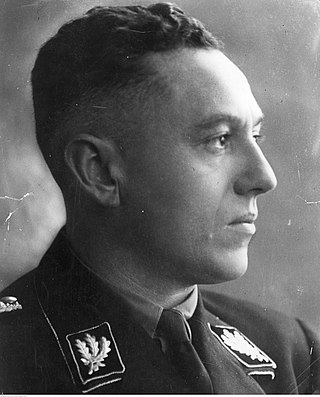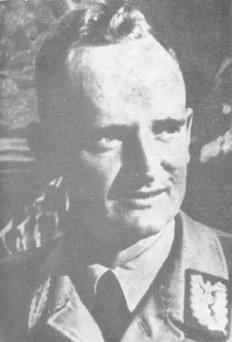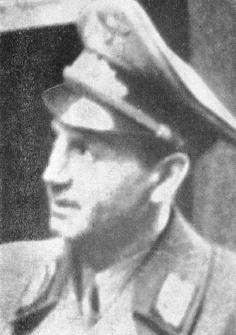
The Reichsgau Wartheland was a Nazi German Reichsgau formed from parts of Polish territory annexed in 1939 during World War II. It comprised the region of Greater Poland and adjacent areas. Parts of Warthegau matched the similarly named pre-Versailles Prussian province of Posen. The name was initially derived from the capital city, Posen (Poznań), and later from the main river, Warthe (Warta).
Reichskommissar, in German history, was an official governatorial title used for various public offices during the period of the German Empire and Nazi Germany.

Reichsgau Danzig-West Prussia was an administrative division of Nazi Germany created on 8 October 1939 from annexed territory of the Free City of Danzig, the Greater Pomeranian Voivodship, and the Regierungsbezirk West Prussia of Gau East Prussia.

Arthur Karl Greiser was a Nazi German politician, SS-Obergruppenführer, Gauleiter and Reichsstatthalter of the German-occupied territory of Wartheland. He was one of the persons primarily responsible for organizing the Holocaust in occupied Poland and numerous other crimes against humanity. He was arrested by the Americans in 1945, and was tried, convicted and executed by hanging in Poland in 1946 for his crimes, most notably genocide.

Erich Koch was a Gauleiter of the Nazi Party (NSDAP) in East Prussia from 1 October 1928 until 1945. Between 1941 and 1945 he was Chief of Civil Administration of Bezirk Bialystok. During this period, he was also the Reichskommissar in Reichskommissariat Ukraine from September 1941 until August 1944 and in Reichskommissariat Ostland from September 1944. After the Second World War, Koch stood trial in Poland and was convicted in 1959 of war crimes and sentenced to death. The sentence was later commuted to life in prison and Koch died of natural causes in his cell at the Barczewo prison on 12 November 1986.

Ostmark was a name that referred historically to the Margraviate of Austria, a medieval frontier march. It was also used in Nazi propaganda from 1938 to 1942 to refer to the formerly independent Federal State of Austria after the Anschluss with Nazi Germany. From the Anschluss until 1939, the official name used was Land Österreich.

A Reichsgau was an administrative subdivision created in a number of areas annexed by Nazi Germany between 1938 and 1945.

Gau is a Germanic term for a region within a country, often a former or current province. It was used in the Middle Ages, when it can be seen as roughly corresponding to an English shire. The administrative use of the term was revived as a subdivision during the period of Nazi Germany in 1933–1945. It still appears today in regional names, such as the Rheingau or Allgäu.

Albert Maria Forster was a Nazi German politician, member of the SS and war criminal. Under his administration as the Gauleiter and Reichsstatthalter of Danzig-West Prussia during the Second World War, the local non-German populations of Poles and Jews were classified as sub-human and subjected to extermination campaigns involving ethnic cleansing, mass murder, and in the case of some Poles with German ancestry, forceful Germanisation. Forster was directly responsible for the extermination of non-Germans and was a strong supporter of Polish genocide, which he had advocated before the war. Forster was tried, convicted and hanged in Warsaw for his crimes, after Germany was defeated.

Joseph Bürckel was a German Nazi politician and a member of the German parliament. He was an early member of the Nazi Party and was influential in the rise of the National Socialist movement. He played a central role in the German acquisition of the Saarland and Austria. He held the posts of Gauleiter and Reichsstatthalter in both Gau Westmark and Reichsgau Vienna.

Gustav Adolf Scheel was a German physician and Nazi Party official. He served as a "multifunctionary" in Nazi Germany, including posts as the Reich Student Leader leading both the National Socialist German Students' League and the German Student Union, as an SS member and Sicherheitsdienst employee, as a Higher SS and Police Leader, as well as Gauleiter and Reichsstatthalter in Reichsgau Salzburg. He was also an Einsatzgruppe commander in occupied Alsace and he organized the October 1940 deportation of Karlsruhe's Jews to extermination camps.

Friedrich W. Rainer was an Austrian Nazi politician, Gauleiter as well as a Reichsstatthalter of Salzburg and Carinthia. He is the only Austrian governor who has ever held the same office in two separate states.

Siegfried Uiberreither was an Austrian Nazi Gauleiter and Reichsstatthalter of the Reichsgau Styria during the Third Reich.

The Gaue were the main administrative divisions of Nazi Germany from 1934 to 1945.

The Operational Zone of the Adriatic Littoral was a Nazi German district on the northern Adriatic coast created during World War II in 1943. It was formed out of territories that were previously under Fascist Italian control until its takeover by Germany. It included parts of present-day Italian, Slovenian, and Croatian territories. The area was administered as territory attached, but not incorporated, to the Reichsgau of Carinthia. The capital of the zone was the city of Trieste.

The Military Administration in Poland refers to the military occupation authorities established in the brief period during, and in the immediate aftermath of, the German invasion of Poland, in which the occupied Polish territories were administered by the German military (Wehrmacht) as opposed to the later civil administration and the General Government.

The States of the Weimar Republic were the first-level administrative divisions and constituent states of the German Reich during the Weimar Republic era. The states were established in 1918 following the German Revolution upon the conclusion of World War I, and based on the 22 constituent states of the German Empire that abolished their local monarchies. The new states continued as republics alongside the three pre-existing republican city-states within the new Weimar Republic, adopting the titles Freistaat or Volksstaat.

The Reichsgau Sudetenland was an administrative division of Nazi Germany from 1939 to 1945. It comprised the northern part of the Sudetenland territory, which was annexed from Czechoslovakia according to the 30 September 1938 Munich Agreement. The Reichsgau was headed by the former Sudeten German Party leader, now Nazi Party functionary Konrad Henlein as Gauleiter and Reichsstatthalter. From October 1938 to May 1939, it was the regional subdivision of the Nazi Party in that area, also under Henlein's leadership. The administrative capital was Reichenberg (Liberec).

The Reichskommissariat of Belgium and Northern France was a Nazi German civil administration (Zivilverwaltung) which governed most of occupied Belgium and northern parts of occupied France in the second half of 1944 during World War II.












